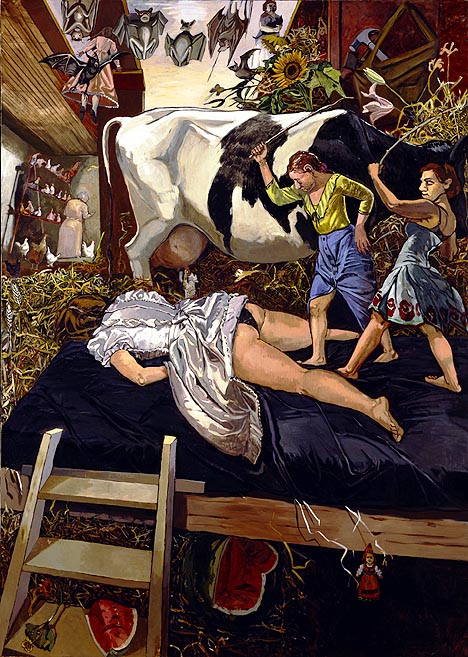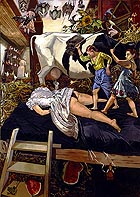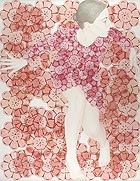
translated and summarized by: Liz Wollner-Grandville,
English summary December 8 - 14
Museu Coleccao Berardo: Nao te posso ver nem pintado
A flood of paintings on the Tagus
It is unusual to find an extensive exhibition of contemporary art in Portugal’s capital. For one, contemporary art is not very popular in Portugal and therefore rarely offered much space, and secondly, Portugal tends to follow the French taste of art, where painting, especially figurative painting, is more or less neglected.
Despite this, the Centro Cultural de Belem is currently showing a selection of contemporary art including photos and videos. The collector José Berardo and the curator Eric Corne initiated this exhibition.
Among the renowned representatives of figurative art, including two early small-format works by Rothko (1937/38), you can find Portuguese works created in correlation with this canon. Luis Noronha da Costa’s blurred paintings of the 70’s remind of Gerhard Richter’s works, but the interspersed surreal elements make it stand out against its supposed model.
Velazquez seems to be a reference for the magical-realistic paintings of the internationally better-known artist Paula Rego. Her neo-expressive work “The Barn” (1994) is created in anticipation of Rauch’s contemporary works. While artists representing the New Leipzig School are missing, the exhibition allows the discovery that there are many outstanding young painters in France: among them Bruno Perramant, Damien Cadio as well as the artist couple Ida Tursic and Wilfried Mille, whose oil painting of a house on fire, taken from Andrei Tarkowski’s film “Victims”, shown at the entrance, opens the exhibit in a quasi explosive way.
Museu Coleccao Berardo
1449-003 Lisbon, Praca do Império, until 24.04.09
www.museuberardo.pt
Albertina: After 1970 – Austrian Art in the Albertina
Characteristic inconsequence
Some things cannot be mentioned often enough. Albertina director Klaus Albrecht Schröder for example, does not become tired of emphasising that drawings “must be taken out of their isolation”. A successful approach – at least for the recent Van Gogh exhibition. Drawings and paintings were juxtaposed in a way that they recharged each other – a phenomenon that, however, does not function at all in the exhibition “After 1970 – Austrian Art in the Albertina”. Although works by such artists as Ulrike Lienbacher, Sonja Gangl, and Adriana Czernin, who have decisively chosen drawings as their artistic medium, are included, a large part of the exhibition shows works by the members of the Group St. Stephan or a group of the Austrian Neue Wilde. Both movements became known through their gestural-abstract paintings, but not through their drawings. It is simply an alibi to present a few paper works by these artists. Admittedly, the selection of every group exhibit can be criticised, and usually one could easily suggest a different selection. But at this exhibit, it remains completely unclear what the exhibition is aiming at. If it was planned to show a valid overview of Austrian art after 1970, then essential positions ranging from Birgit Jürgenssen and VALIE EXPORT, Peter Kogler and Eva Schlegel to gelitin and Dorit Margreiter are missing. And only a few works by the internationally most renowned artists Franz West and Erwin Wurm are jammed into a narrow throughway. Instead quite a few – at best - regionally known artists are represented. They do, however, primarily dedicate their work to the graphic arts. But if one would have really wanted to put together a show focussing on graphic art, the renowned painters from the 1960s – and 1980s were superfluous. Therefore this exhibition remains absolutely inconsequential.
Albertina
1010 Vienna, Albertinaplatz 1, until 11.01.09
www.albertina.at
Secession: Sharon Lockhart
Union Art
Films and photographs by the American artist Sharon Lockhart, born 1964, are currently shown at the Secession.
Over the period of an entire year Lockhart worked at a wharf in Maine, positioned herself in front of the wharf’s entrance gate, and also analysed the goings-on in the corridors, the staffrooms, as well as taking close-ups of the dirtied faces of the workers. She created two films and three photo series on this topic.
A lengthy 80-minute tracking shot observes the workers during their lunch break. The lunch box content is photographed in detail, as is the coffee and snack bar. And for the course of an entire week Lockhart filmed the staff as they dispersed upon leaving the wharf after hours.
But when do these people actually work? Do they only eat, rest, and then leave? Is this really meant to be a documentation of a working-class environment? Apparently this is the working-class environment, and Lockhart is presenting the achievements of 150 years of social battles. The harsh reality, as it is presented here, is under the guardianship of social democracy, and it is really worthwhile to demonstrate the fruits of “having a break”. Today’s social realism is called Union Art. Was that really the intention?
Secession
1010 Vienna, Freidrichstrasse 12, until 18.01.09
www.secession.at
Bawag Contemporary: Christoph Weber
Traces of the material
In May 1968, the barricades in Paris were actually quotes, and their context was history: their chaotic and spontaneous positioning served more as a historic reprimand than a defence against the counterrevolutionary evil. They activated the cultural remembrance of another hugely important event: the Paris Commune. In 1871 the uprising was violently broken and Christoph Weber extracted a cobblestone from the exact location where the last barricade was set up. The artist replicated the cobblestone out of papier maché by using pages from French books dating up to 1871. A huge pile of these paper stones is now exhibited at the BAWAG Contemporary in Vienna.
Agitators during the Thirty Years War had to do without words – too many people at that time were illiterate. They were therefore the first to employ caricatures and copperplate printed flyers. Weber enlarged and filled an entire wall with copper stripes, symbolising the rising smoke clouds depicted on one of these drawing from 1631. A third creation by Weber shows groups of dented metal sheets either stacked, hanged, or piled.
Weber’s specific handling of these materials does not only uncover surfaces, but also social history. The traces in the material seem to relate to those marks, which remain in a social context.
Bawag Contemporary
1060 Vienna, Barnabitengasse 11-13, until 14.01.09
www.bawagcontemporary.at
Mehr Texte von translated and summarized by: Liz Wollner-Grandville


 Teilen
Teilen





